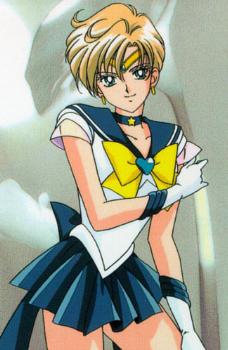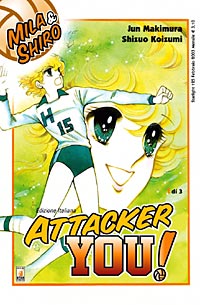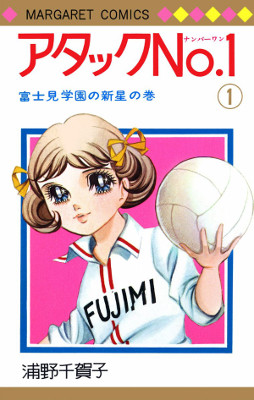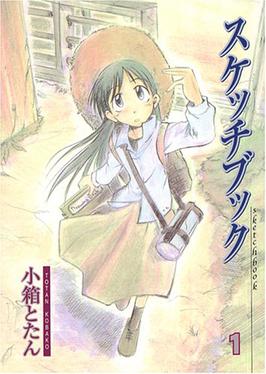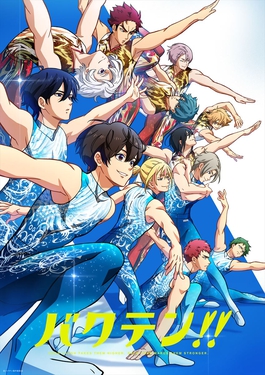This article needs additional citations for verification .(July 2017) |
The story is about Hikari Kamijou, a fifteen-year-old [note 1] girl who develops a passion for the sport of rhythmic gymnastics when she sees her idol, Diliana Georgieva, perform and win a contest of rhythmic gymnastics. Diliana proposes to train Hikari in Bulgaria, and Hikari accepts. She begins her training and joins her school's rhythmic gymnastics team.
At first Hikari lacks natural skill, but then she meets Takaaki Ooishi, a fellow gymnast and popular schoolmate who helps her to improve. With his support, Hikari's talent blossoms, landing her on the map of popularity along with the best rhythmic gymnast at her school, Hazuki Shiina. [1] [2]
As Hikari and Hazuki begin training for the World Cup competition together, a healthy rivalry develops. [3] Hikari longs to embody Hazuki's graceful elegance, and seeks out Mao Natsukawa to help.
Mao is a childhood friend and the lead singer of a rock band, and he dreams of becoming a world-renowned rock'n'roll idol. Mao helps Hikari by creating music for her performances, and together they win the respect and admiration of the viewers who watch them perform.
Over the years, Mao has come to love Hikari deeply, but Hikari has fallen in love with Takaaki Ooishi. While this causes a rift in Hikari and Mao's relationship, he remains a loyal friend. When Hikari discovers that Hazuki also has feelings for Takaaki, they become rivals in sport and love. Hikari does not know how Takaaki feels about her, and worries Takaaki might fall for Hazuki because of her gymnastic talent. Hikari begins to perfect her skills, and is soon competing at the national and international level.
In the TV series, Hikari wins Ooishi's heart and we are shown a little flash forward: Hikari is an Olympic champion, Ooishi is recovering from a lesion but with Olympic expectations, Mao is working on his career as a musician and Hazuki has retired and is working with as a trainer for young children who want to be gymnasts. [4]
The end in the manga version
Hikari goes on to win a national competition, giving her the opportunity to compete at the Seoul 1988 Summer Olympics. While Hikari has finally surpassed Hazuki in terms of ability as a rhythmic gymnast, their rivalry for Takaaki Ooishi's affection is still going strong.
When Hikari, Mao, Hazuki, Takaaki and rest of the athletes competing in the 1988 Summer Olympics travel to Seoul, Hikari finds out that Ooishi and Hazuki are in love and that they are set to be married. Hikari turns to Mao Natsukawa for support, but he becomes frustrated with her for ignoring his own love for her. When Mao leaves Hikari, she realizes that she has feelings for him, too. Even while he is not there to watch her compete, Hikari is determined to prove to Mao that he is an important part of her life and her success.
At the end of the manga, Hikari is competing at the 1988 Summer Olympics. While she is performing, Mao begins to sing an Italian love song, even though vocal music is banned during competitions. Despite this Hikari and Mao finish their performance, prompting applause from the crowd and their friends, Takaaki and Hazuki, who have come to see them perform. Before the winner is announced, both Hikari and Mao exit the competition arena. The manga concludes with Hikari smiling, hinting that in the end she may have not won a medal, but that she will have a bright future with Mao.
Media
Manga
The manga was serialized in Japan in the weekly publication Margaret Magazine by Shueisha, with the first installment issued in February 1986. The manga series finished in 1988 collected in 16 small volumes. The manga series would at times contain parodies of famous 80s musicians that were popular of its publishing. For example: In the eighth volume of the manga series the author makes a parody of popular 80s singer Cyndi Lauper by drawing Hikari with the same hairstyle, skirt, and posture that the singer had on the She's So Unusual album cover. Recently in 2000 the manga series was reissued in Japan, collected in 8 volumes in bound tankōbon form, with less volumes, but with more chapters inside them and larger pages. The new reissued version of the manga also featured different covers from the original. These new covers feature a mixture of photos in black and white of rhythmic gymnasts performing, and black and white drawings of Hikari. The manga series was also released in Italy by Star Comics and serialized through Starlight (a publishing branch of Star Comics). Prior to the release of the manga in Italy, a Films comic version based on the TV series was made in the 80s was released in the country, but the images and dialogue were poor and not all the stories were covered, however it was appreciated by fans. The Italian version of the manga was titled "La leggenda di Hikari" (which literally means The Legend of Hikari) and collected in 16 small volumes with slightly altered covers from the original. Edizioni Star Comics re-released the manga series in Italy starting with the first volume released in May 2003 for the price of 3,10 Euro. The manga series was finished being released in 16 volumes in August 2004. [5] The manga has yet to be released in Germany, France, and Spain, where the TV series was also very popular.
Anime
The anime series which was produced by Tatsunoko Production with Tomomi Mochizuki as head director originally aired on ABC from May 3, 1986, to September 20, 1986. It was aired on TV as another mainstream Saturday night anime series from 7:00-7:30 pm (19:00-19:30). The anime series was molded with information from the original story given by Izumi Aso, scripted with the participation of Hideki Sonoda, Mami Watanabe, Yasushi Hirano. While the anime had a lot to do with gymnastics it also had a good amount of music which was directed and arranged by Eiji Kawamura with lyrics from Goro Matsui who provided both opening and ending themes. Character Design was done by Michitaka Kikuchi, and Toyoko Hashimoto. Hisato Otaki was the art director. The Animation directors were Chuuichi Iguchi, Matsuri Okuda, Naoyuki Onda, Takayuki Goto, and Yumiko Suda. The Director of Photography was Kazunori Hashimoto and background artist was Kumiko Tada. All these people were assisted by Aso who was used as an adviser to maintain certain plot ideas and character development in the right direction. [6]
Episode list
Like many popular manga series of the time (this is still done today), Legend of Light was turned into an anime series. At the time the producers of Tatsunoko Productions had picked the manga series to produce it into an anime series. It was first aired in Japan in early 1986. At the time the manga series was still unfinished so the producers of the anime were not sure how long the anime would last since the manga was not finished. Finally they settled at 26 episodes (the average number of episodes done per anime series, at the time highest number of episodes was 52). Due to poor ratings in Japan, the series was left unfinished at only 19 episodes with the last couple of episodes wrapping up the series in a hurry and left in an open ending in late 1986. The series was aired again abroad during the 1988 Olympics that were happening in Seoul, Korea in hopes that it would help boost the ratings of the anime series. Later on in 1988, the series was released in Europe where it was extremely successful, especially in France, Germany, Italy, and Spain. In every country where the series was released, the titles of the anime episodes were changed. The episode titles of the English version are translations of the original Japanese episodes titles.
Theme songs
| Hikari no Densetsu | |
 Hikari no Densetsu, Vol. #1 | |
| 光の伝説 (Legend of Light) | |
|---|---|
| Genre | Sports, romance, slice of life |
| # | Song title | Episodes | Notes |
|---|---|---|---|
| 1 | "Haato no kisetsu" (ハートの季節) | 1-19 | 1986 - Japanese
|
| 2 | "Kataomoi no hamingo" (片思いのハミング) | 1-19 | 1986 - Japanese
|
| 3 | "Hilary" | 1-19 | 1988 - Italian
|
| 4 | "Se stai con me" | n/a | 1988 - Italian
|
| 5 | "Il vento" | n/a | 1988 - Italian
|
| 6 | "Quando tornerai" | n/a | 1988 - Italian [7]
|
| 7 | "Cynthia ou le rythme de la vie" | 1-19 | 1988 - French (translated from the original Italian song)
|
| 8 | "Quand tu reviendras" | 1-19 | 1988 - French
|
| 9 | "le vent" | 1-19 | 1988 - French
|
| 10 | "Si tu parles avec moi" | 1-19 | 1988 - French
|
| 11 | "Piruetas" | 1-19 | 1991 - Spanish (translated from the original Italian song)
|
| 12 | "Die kleinen Superstars" | 1-19 | 1994 - German (translated from the original Italian song)
|
